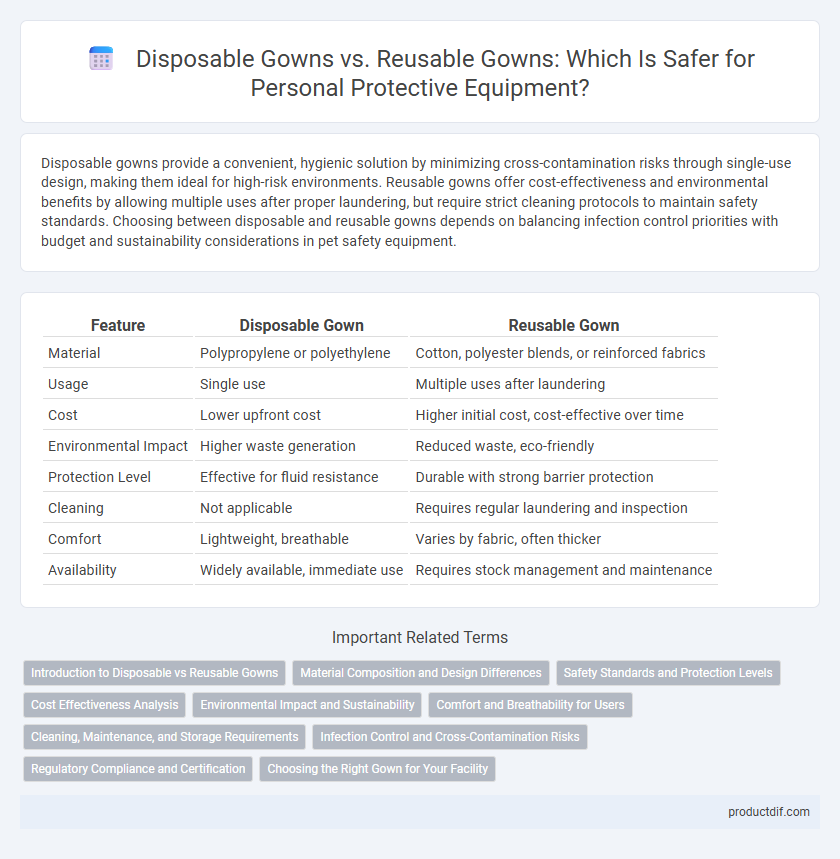Disposable gowns provide a convenient, hygienic solution by minimizing cross-contamination risks through single-use design, making them ideal for high-risk environments. Reusable gowns offer cost-effectiveness and environmental benefits by allowing multiple uses after proper laundering, but require strict cleaning protocols to maintain safety standards. Choosing between disposable and reusable gowns depends on balancing infection control priorities with budget and sustainability considerations in pet safety equipment.
Table of Comparison
| Feature | Disposable Gown | Reusable Gown |
|---|---|---|
| Material | Polypropylene or polyethylene | Cotton, polyester blends, or reinforced fabrics |
| Usage | Single use | Multiple uses after laundering |
| Cost | Lower upfront cost | Higher initial cost, cost-effective over time |
| Environmental Impact | Higher waste generation | Reduced waste, eco-friendly |
| Protection Level | Effective for fluid resistance | Durable with strong barrier protection |
| Cleaning | Not applicable | Requires regular laundering and inspection |
| Comfort | Lightweight, breathable | Varies by fabric, often thicker |
| Availability | Widely available, immediate use | Requires stock management and maintenance |
Introduction to Disposable vs Reusable Gowns
Disposable gowns provide single-use protection, reducing the risk of cross-contamination in healthcare settings. Reusable gowns offer durability and cost-effectiveness but require stringent laundering protocols to maintain safety standards. Selecting between disposable and reusable gowns depends on factors such as infection control, budget constraints, and environmental impact.
Material Composition and Design Differences
Disposable gowns are typically made from lightweight, non-woven polypropylene or polyethylene materials that provide barrier protection against fluids and contaminants, designed for single-use to prevent cross-contamination. Reusable gowns often utilize durable fabrics like tightly woven cotton, polyester blends, or waterproof-coated textiles, allowing for repeated laundering without significant degradation of protective properties. Design differences include disposables' simpler, often loose-fitting construction prioritizing convenience and quick disposal, while reusable gowns feature reinforced seams, adjustable closures, and enhanced durability to withstand frequent cleaning cycles and extended wear.
Safety Standards and Protection Levels
Disposable gowns comply with ASTM F3352 safety standards, offering high fluid resistance and barrier protection for single-use scenarios, minimizing cross-contamination risks. Reusable gowns meet AAMI PB70 protection levels, providing durable, multi-wash resistance suited for prolonged use in high-risk environments while maintaining effective fluid and microbial barriers. Selecting between disposable and reusable gowns depends on specific safety protocols and contamination control requirements in healthcare settings.
Cost Effectiveness Analysis
Disposable gowns incur higher long-term costs due to continuous purchasing and waste disposal, while reusable gowns require upfront investment in laundering and maintenance but offer reduced expense over time. Cost effectiveness analysis reveals reusable gowns save money in high-usage environments by lowering per-use costs and minimizing environmental footprint. Facilities must evaluate volume, laundering infrastructure, and infection control standards to determine the most economical option.
Environmental Impact and Sustainability
Disposable gowns generate significant medical waste and contribute to landfill accumulation, increasing environmental pollution and resource consumption. Reusable gowns, made from durable materials, reduce waste through multiple uses and lower carbon footprints when properly sanitized with eco-friendly processes. Choosing reusable gowns supports sustainability goals by conserving resources and minimizing the ecological impact of healthcare facilities.
Comfort and Breathability for Users
Disposable gowns typically offer lightweight materials with moderate breathability, reducing heat buildup during extended wear but may lack the softness found in reusable fabric gowns. Reusable gowns, often crafted from cotton or polyester blends, provide enhanced comfort through better moisture absorption and improved airflow, making them ideal for prolonged use in healthcare settings. User preference frequently depends on balancing breathability and material softness with the practical need for infection control and durability.
Cleaning, Maintenance, and Storage Requirements
Disposable gowns require no cleaning or maintenance, eliminating cross-contamination risks and simplifying storage as they can be discarded after single use. Reusable gowns demand thorough washing, typically involving high-temperature laundering and disinfection protocols to maintain protective integrity and comply with safety standards. Proper storage of reusable gowns includes drying in contamination-free environments to preserve material quality and prevent microbial growth.
Infection Control and Cross-Contamination Risks
Disposable gowns offer superior infection control by providing a fresh, uncontaminated barrier for each use, significantly reducing cross-contamination risks in clinical settings. Reusable gowns, while cost-effective, require stringent laundering protocols to maintain their protective integrity and prevent pathogen transmission. Choosing disposable gowns minimizes the risk of healthcare-associated infections by ensuring consistent microbial protection between patient interactions.
Regulatory Compliance and Certification
Disposable gowns typically comply with ASTM F2407 standards, ensuring single-use infection control, while reusable gowns must meet AAMI PB70 Level 3 or higher for multiple wash cycles. Regulatory compliance for reusable gowns requires rigorous testing for barrier effectiveness after each laundering to maintain certification. Certification from bodies such as FDA clearance for disposables and ISO 13485 for reusables ensures adherence to safety and performance criteria in medical environments.
Choosing the Right Gown for Your Facility
Choosing the right gown for your facility involves evaluating factors such as infection control standards, cost-effectiveness, and environmental impact. Disposable gowns offer superior contamination control by reducing cross-infection risks, while reusable gowns provide long-term cost savings and sustainability through multiple laundering cycles. Assessing patient acuity, facility workflow, and compliance requirements ensures optimal selection between disposable and reusable safety gowns.
Disposable gown vs Reusable gown Infographic

 productdif.com
productdif.com